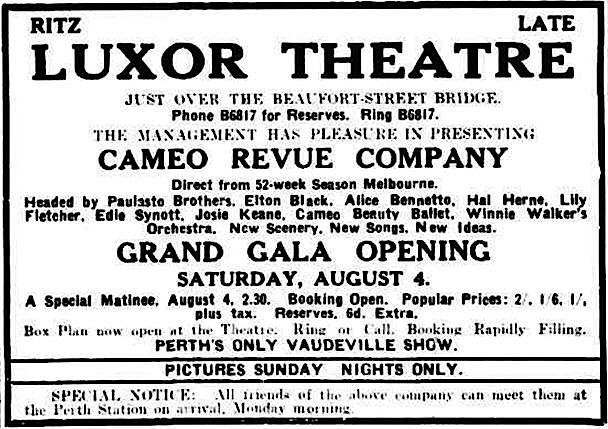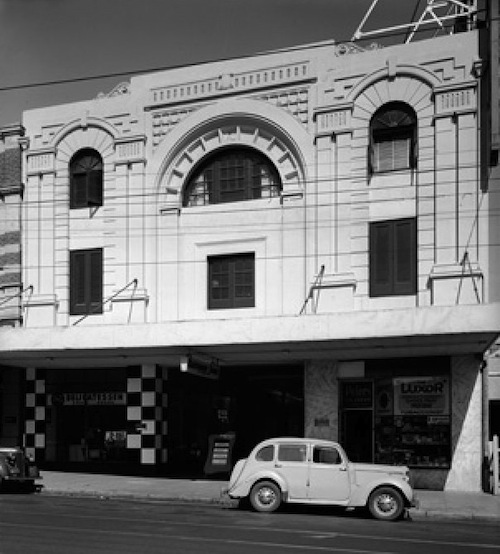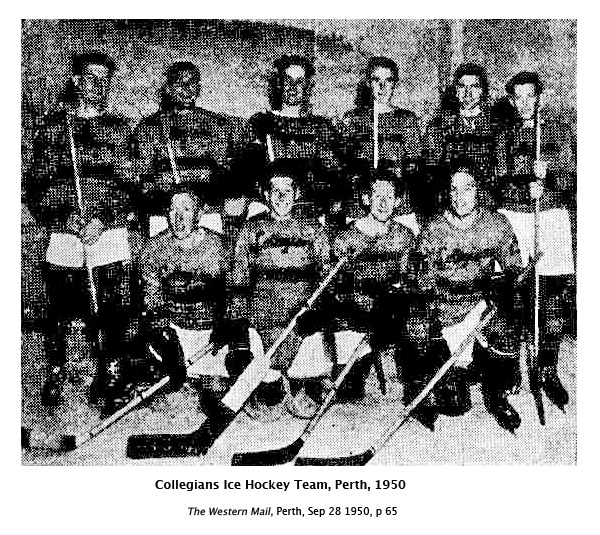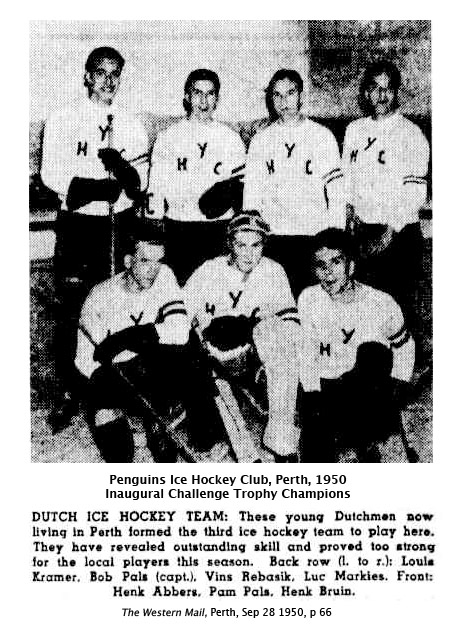Legends
home
From a desert, from the driest continent, from this land at the opposite end of the globe ...
... as remote as could be in the hockey world ...
... came one of the world’s oldest winter sports trophies.
A cool tradition, a dream of champions, and a story we owe it to our children to tell.
Legends of Australian Ice.
[ HISTORY ] Ice Sports in Western Australia
Homes of Australian Ice Hockey
![]() It started as a woodyard (owned by a firm still in business in Perth); it graduated to a penny arcade with sideshows; it became Perth's first open-air silent picture theatre (Admission: Adults, sixpence: children, threepence, or empty bottles); it became a revue house; it turned into a boxing and wrestling stadium; it switched back to the stage, but dropped a peg or two with low-class vaudeville; it raised its tone and became a better-class vaudeville theatre; it finished its theatrical career (for the time being, at any rate) with a season of a Noel Coward comedy followed by a season of Shakespeare; and it won't be long now before it will be echoing to the sounds of the Skaters' Waltz, the cutting of skates and the bumps and screams of bouncing beginners. — Elaine Lynch, The Daily News, Perth, 21 November 1949.
It started as a woodyard (owned by a firm still in business in Perth); it graduated to a penny arcade with sideshows; it became Perth's first open-air silent picture theatre (Admission: Adults, sixpence: children, threepence, or empty bottles); it became a revue house; it turned into a boxing and wrestling stadium; it switched back to the stage, but dropped a peg or two with low-class vaudeville; it raised its tone and became a better-class vaudeville theatre; it finished its theatrical career (for the time being, at any rate) with a season of a Noel Coward comedy followed by a season of Shakespeare; and it won't be long now before it will be echoing to the sounds of the Skaters' Waltz, the cutting of skates and the bumps and screams of bouncing beginners. — Elaine Lynch, The Daily News, Perth, 21 November 1949.
THE BIRTH OF ICE SPORTS IN PERTH was not in a tin shed. Not in some 1980s industrial estate as we had come to accept in Australia in the decades before Medibank Icehouse. Perth's first ice rink was installed in 1949 at the city's home of vaudeville, Beaufort Street, in Northbridge. It was in the converted Tivoli Theatre which today is part of the former Myer Megamart near Perth station, the first on the right as drivers enter Beaufort Street from the CBD.

The Tivoli building had begun life in 1911 as a semi-open air picture theatre with a seating capacity for 2,000 people known as the Shaftesbury Gardens. Its owner-builder, Tom Shafto, was a Perth City councillor and owner-builder of the Shaftesbury Hotel located in the same block. In 1915, he closed down a sideshow arcade and showed the first silent picture there. It was all done in the open air with the screen positioned where the theatre entrance was later located. By 1922, the site was properly established as a picture theatre with canvas seats, some raised into a dress circle. A small stage was built so that a few acts could be run in conjunction with the picture programme.

Luxor Theatre, Beaufort St, Perth, 1937, later the Tivoli
When Shafto retired to his hotel, his sons Tom, Ron and Dick built a proper stage with dressing rooms, stage properties and lighting. There was a roof over the theatre by this time, but it was unlined. On the opening night of the first revue it rained and the leading lady refused to go on stage. The tin roof allowed nothing to be heard above the din of the rain. At one time or another, the Shaftesbury (1912), the Luxor (1925) and the Tivoli (1944) each occupied the site. It was a celebration of Perth's home of vaudeville where comedians, clowns, tumblers, acrobats, magicians and dancing girls performed.
This fleapit theatre continued as the Shaftesbury until 1924, re-opened as the Luxor in 1925, which was then renamed the Ritz in 1934. From about 1935 on — when the Shafto boys gave it up — the theatre degenerated into a low-class vaudeville theatre featuring strip-tease acts and leg shows under the name of the Hollywood Theatre. After this, it was a boxing and wrestling stadium for a short time until in 1943 it was leased by Bruce Carroll, brother of theatrical entrepreneur, Garnet Hannell Carroll (1902 – 1964) in Melbourne — a partner of Sir Benjamin Fuller. A fews years later in 1946 they established the Carroll-Fuller Theatre Company Pty Ltd.

In 1944 Carroll bought the property, changed the name back to the Luxor Theatre, and soon after to the Tivoli Theatre. From then on, things took a turn for the better and the public of Perth saw the pantomime Cinderella, the all-male show The Kangaroos and Noel Coward's record breaking comedy Present Laughter. A series of Shakespearean plays were presented there. After World War II Carroll's brother brought many famous companies to Australia, including the Ballet Rambert (1947-48), the Old Vic Theatre Company with Sir Laurence (Lord) Olivier and Vivien Leigh (1948), and the Shakespeare Memorial Theatre Company (1949).
Ice Palais Ltd formed late-1948 with Carroll as its managing director and later chairman of directors. The pantomime Jack and the Beanstalk and Hello 1949 were among the last shows at the Tivoli, finishing at the end of January 1949. Dogged by industrial strife, remodeling consumed most of the year, but the rink premiere was held on the evening of Tuesday December 13th 1949. It opened to the public the next day. More than 1,200 persons attended the premiere as guests of the management. The interior was ice-blue with Arctic landscape drawings on the walls. The band played the "Skater's Waltz" from the theatre's old stage, Carroll introduced the rink manager, Edson Richard Banks, the former proprietor of the Silver Dollar Cabaret, and then ice skating made its debut.

The first ice pad was smaller than half international hockey size. Its dimensions were originally reported as 95ft (28.9m) by 85ft (25m), but it may have been just 70ft (21.3m) x 60ft (18.3m). Four skating instructors from the UK and eastern states gave ice dancing, trick skating and speed skating exhibitions. Perth's first speed skating championships concluded there on April 22nd 1950 with Nola Gault and L Anderson winning the women's and men's titles. The city's first Ice Ballet was staged there on April 25th 1950 with 22 local girls and 3 professional instructors. It was produced by Melbourne professional skater, Charles Armstrong, and other shows soon followed.
On May 22nd 1950, the Bulldogs defeated Wildcats, 8-7 in the first women's basketball match on ice. On June 6th, two motor cyclists raced on machines fitted with a skate suspended between the front forks in place of a wheel. Each machine was equipped with studs on the rear wheel to bite into the ice. The races were held over ten laps between George Scott, a well-known Perth motor cyclist, and Jack French, a noted rider from Melbourne. New York's Cissy Trenholm from the Sonja Henie Show at the Centre Theatre NY trained there for Ice Follies in August 1950 and Mirey Reid, Sydney's foremost instructor, gave private lessons under special contract. The English professional instructors, Audrey Laxton and Eric Stanbrook, taught there in the 1951 season. Laxton later published the skating book, Someone Like Me (1963).

The building that became the Perth Ice Palais, Beaufort St entry. Note the Luxor Theatre sign in the window.
Ice hockey made its Perth debut when Western Dodgers played Collegians on the evening of Monday July 3rd 1950. The Dodgers were coached by two former Victorian ice hockey stars employed by Perth Ice Palais. Ray Abbott played for the Tigers who won the 1949 VIHA premiership and Bob Cody was with the Blackhawks who won in 1947. Both teams were from the newly-formed Western Australian Ice Hockey Association and they played 5-men a side. The crowd loved it and why not? They were seated in comfort. The hiss and scurr of the skates, the crashing of the sticks and the thud of the puck on the sidewalls, was mostly all lost in the yells of encouragement to the players. The roar that greeted the scoring of each goal drowned even the referee's whistle.
Brian Strack of the Collegians ice hockey team was considered a top player of the time. He played senior field hockey for Western Australia, not unlike Benny Acton in Melbourne. Acton was a field hockey player who later captained Australia in ice hockey at the 1960 Olympics. Strack had said he found his nine years field hockey experience a great asset and he thought that playing on a miniature rink was more conducive to teamwork. With the small playing surface, opposing defenders were able to keep a close watch on the attacking forwards, which made frequent passing of the puck necessary. Strack, who made his fourth trip with a State field hockey side in 1950, was the only member of the Perth ice hockey clubs to play first-grade field hockey.
A third team joined a few months later. Composed of Dutch migrants, Perth Penguins were formed by 22 year-old Bob Pals who said he had represented Holland in the amateur championships at Montreaux in Switzerland in 1948 and played many international games against France and Belgium. His younger brother, Pam, was a goalie who had represented Holland in 11 internationals. Other members of the team were Luc Markies, who won seven medals for long-distance skating events in Holland, including 100 mile races; Louis Kramer, a leading figure and dance skater on Dutch and English rinks; and Rudi Willems, who also played international games for Holland and was a member of the Amsterdam Icebergs.

Gear was purchased from the eastern states or improvised when the cost was too great for the individual concerned. it was discovered by trial and error at practice that five players to a side was the maximum that could be accommodated on the small rink and there were special rules for goalkeepers and forwards because the goals were placed flush with the ends of the rink, instead of six feet in from the boards. Bert Craven, a professional skater at the Palais, gave his services as referee and adviser, while Carter, the Dodgers' captain-coach, passed on the benefit of his wide skating experience. The superior play of the migrants was offset to some degree by the smallness of the rink.

The Penguins won the first premiership in 1950 without losing a match. The West Australian Ice Hockey Association resumed in April 1951 with four teams: Western Dodgers, Collegians, Penguins and a new team named Magpies that included two American players in its line-up. Its captain was Francis Bergeron of Leominster, Massachusetts, who had played for his State league. All four teams were strengthened numerically and the local press anticipated faster play "as each team will be able to send in replacements more often than was the case last season". New rules were adopted corresponding with the British Ice Hockey Association, with adjustments to rink markings for one-third international size. League matches played May through to September after which a new competition for the Challenge Trophy commenced. The finals between the top two teams were played on October 11.
Despite all this, the Ice Palais closed after just two seasons on Saturday February 2nd 1952. The original Ice Palais Prospectus had intended to expand business operations into large-scale freezing and refrigeration like its counterparts in the eastern states. But, in the end, the company accountants said overhead costs such as power for refrigeration had increased until it was impossible to carry on. A few months later, Bruce Carroll, the founder of Perth Ice Palais, died suddenly on a theatrical tour of New Zealand at the age of 49.

The Ice Palais building was again converted, this time for dancing. In 1955 it became Canterbury Court Ballroom with a muti-story car-park added above in 1969. It was demolished in 1990 and the site became Myer Megamart (2001). In 2014, it was proposed to build Perth's tallest skyscraper on the site.
![]() Images | 01 | 02 | 03 | 04 | 05 | 06 | 07 |
Images | 01 | 02 | 03 | 04 | 05 | 06 | 07 |
References:
1. West Australian, 25 October 1949 p 9. Ice Sports Planned for New Perth Rink
2. The Daily News, Perth, 21 November 1949 p 6. Article by Elaine Lynch.
3. West Australian, Perth, 1 May 1951 p17. Perth Ice Hockey Players' Move to Boost Game
